Table of Contents
What is Remy Hair?
There are still many doubts about what Remy’s hair is. Many people get confused and think that Remy’s hair is virgin hair, or that it is treated hair, or that it is full hair at the ends, or that the seam is more reinforced, etc. All this is a myth; let’s clarify once and for all the meaning of Remy’s hair
Currently, on the market, there are some models and options of wigs for all tastes and needs. They can be straight, curly, afro hair, short, long, full laces, front laces, etc. But each accessory’s big difference is in the type of hair used in its making. After all, which hair option is better for a wig: natural or synthetic?
To know this, it is also necessary to understand some aspects, including behavioural ones, as each person has different needs. For example, some prefer wigs with more durable material so they can wear them longer; others want an accessory that only lasts for a limited time or a special occasion.
Or even we must also consider other needs, such as greater practicality in handling the hair since some models can tangle more easily. Or, if you like to style your wig with a flat iron, curling iron, dryers and the like, it’s always good to know what type of hair you should or shouldn’t buy.
So, to help you understand the a little better about the subject, we will show you what differentiates one type of hair from another.
Human / Natural Hair
Human hair is undoubtedly the hair type that is most loved and appreciated by most people, mainly due to its high durability and natural appearance. It is also the type of hair that can receive chemicals, heat tools and the like, and which usually tends to have a smoother appearance when going through the flat iron and with beautiful curls after the curling iron. But despite having more resistance, they also need the same care you would apply to your hair; you have to wash, condition, moisturize, etc.
Care And Maintenance For Natural Hair Hair
Many human hairs destined for the manufacture of wigs, hairpieces, and prostheses have gone through some chemical process to remove dyes, products and treatments that the donor has performed, or even some modification so that the accessory can adjust to the taste of the donor. In this case, it may be that the wire has undergone some change to stay that way. There are also situations where the accessories may have been custom-made.
Virgin And Unprocessed Hair
There are also types of virgin human hair, those without any intervention, usually from Asia and Brazil (the most requested), and unprocessed hair ( Unprocessed Remy Human Hair ). Both are examples of hair considered rare in the market, so they are costly.
Natural Hair (Remy Hair)
If you enjoy this hair universe, you have seen wig ads in which the name “Remy Human Hair” appears in the sales title. After all, what would that be?
“Remy Hair” is natural hair that only has its cuticles intact and all in the same direction (processed hair). It may have already undergone some (chemical) alteration to suit the market or collected from different donors, but that’s about it. What matters in this type of hair is precisely the part of the cuticles, which in fact, need to be in the same tune, directly implying the thread’s quality. Also Read Hair Extensions
What Are Cuticles?
We can say that the cuticle is the layer or outer part of the hair. It should initially point entirely towards the end of the hair shaft, which characterizes a protective shield for the hair’s inner structure. Hair tends to tangle and tangle when this protective layer is damaged much more quickly, offering a rougher texture. The cuticles cannot be seen with the naked eye but can feel by touch.
How To Identify A Remy Hair?
To tell if a hair is “Remy”, you must slide your fingers along a single strand in a downward-to-up direction. If you feel something rougher or the hair stands up during the process, it is not “Remy” hair. But if the result is the opposite, and when you run your fingers. You feel a smoother strand without changes, this is natural Remy hair.
For you to understand better, hair that is not “Remy” (or “Remi”) will usually collect in several ways, including through brush strands. After that, the companies gather all the material and carry out an acid bath to improve the appearance of the layers of the wire and make it thinner. From there, the hair accessory will make for sale.
In the case of “non-Remy”, after a certain amount of washing, the silicone in the layers disappears, and the wires tend to tangle much more quickly. It is no wonder that many wigs twist in such a way that sometimes it is even challenging to undo the knot, requiring the help of a professional to fix the damage.
Advantages of Remy Hair
1 – More natural look
2 – Allows you to model and cut as you want
3 – Healthier and more durable hair
4 – Allows dryers, flat iron, curling iron, dye less bleaching.
Conclusion
The only disadvantage of this kind of product is that it is usually a little more expensive than synthetic hair wigs but cheaper than virgin or unprocessed hair. However, it is still an excellent value for money.
As the hair grows from the scalp, the thickness of the strands thins over time, as it takes years to develop. Therefore, sometimes NON-Remy hair looks better because it has thicker ends, as about 50% of the threads will see in reverse, at the end of the lines and not at the root. Another and no less critical detail is that they are cheaper, as they are much easier to obtain.

